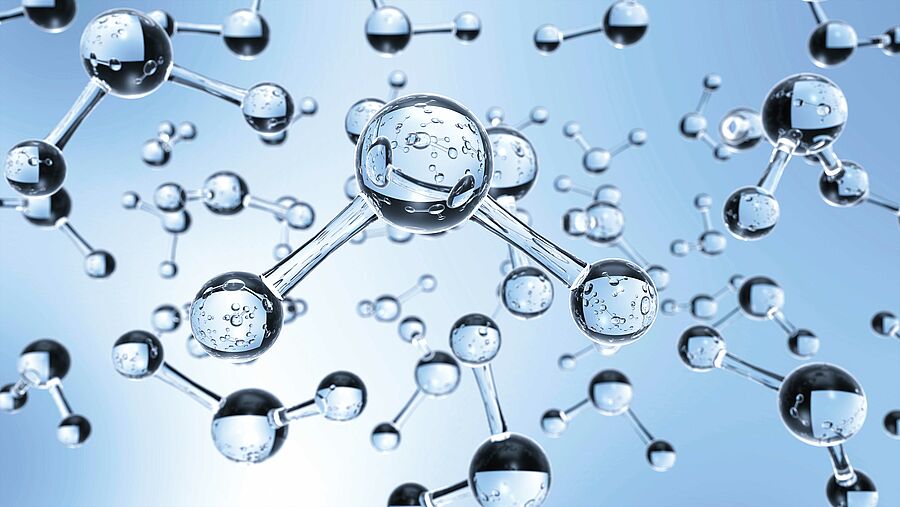New Technologies for Sustainable Hydrogen Production
In addition to electrolysis, we at AIT are researching alternative methods for hydrogen production, including photoelectrochemical water splitting (PEC) and photocatalytic water splitting. Both approaches utilize light energy to sustainably extract hydrogen from water.
Our work focuses on developing efficient materials, optimizing processes, and examining the technical feasibility of these technologies. The goal is to provide practical solutions for renewable hydrogen production that are both resource-efficient and economically viable.
Photoelectrochemical Water Splitting
Photoelectrochemical (PEC) cells are devices that utilize light to drive chemical reactions, typically for water splitting to produce hydrogen. A PEC cell integrates photoelectrodes that absorb sunlight and generate charge carriers. These photoelectrodes are immersed in an electrolyte, where the chemical reactions take place. The photoanode drives the oxygen evolution reaction (OER), while the photocathode controls the hydrogen evolution reaction (HER). These systems offer a promising pathway for renewable energy conversion, as they directly transform solar energy into chemical energy without intermediate steps.
Research on PEC Technology at AIT
- At AIT, we develop photoanodes and photocathodes for OER and HER based on earth-abundant materials, such as kesterite (copper-zinc-tin-sulfide), copper oxide photocathodes, and hematite (iron oxide) photoanodes.
- We design and fabricate heterojunction photoelectrodes that address challenges related to efficient charge carrier separation and transport while maintaining high catalytic activity.
- We simulate and manufacture photonic and plasmonic nanostructures that enhance the light absorption efficiency of the photoelectrodes.
Challenges of Photoelectrochemical Water Splitting
The development of PEC systems faces several key challenges, including improving the stability, efficiency, and scalability of photoelectrode materials while minimizing costs:
- Material Stability: Many photoelectrode materials degrade under the harsh conditions of PEC cells, especially with prolonged exposure to light, water, and reactive species. Photo-corrosion of semiconductors, particularly in oxidative or reductive environments, limits the device lifespan.
- Efficiency: The limited solar-to-hydrogen (STH) efficiency results from insufficient light absorption, low charge carrier mobility, and poor charge separation in some materials. The recombination of photogenerated electron-hole pairs reduces the effective photocurrent.
- Catalyst Integration: Effective catalysts are required to reduce the overpotential for OER and HER. Integrating catalysts with photoelectrodes without compromising light absorption or stability remains a challenge.
- Scalability and Cost: High-performance materials such as III-V semiconductors or noble metal catalysts are expensive and difficult to implement on a large scale for hydrogen production. Developing materials based on abundant and cost-effective elements without sacrificing performance is crucial.
- Integration and Device Architecture: Efficient coupling of light absorption, charge transport, and catalytic processes within a single device is complex.
Addressing these challenges requires a multidisciplinary approach, combining advances in materials science, nanotechnology, and device engineering to develop robust and efficient PEC systems for sustainable hydrogen production.
Photocatalytic Water Splitting
Photocatalytic water splitting is a process that utilizes light-activated catalysts to split water into hydrogen and oxygen, providing a sustainable method for renewable hydrogen production. Upon illumination, photocatalysts absorb photons to generate electron-hole pairs, which drive the reduction and oxidation reactions necessary for hydrogen and oxygen evolution. Effective photocatalysts must have appropriate band gap energies, efficient charge separation, and long-term stability in water. Commonly used materials include metal oxides, sulfides, and nitrides, which are often modified with co-catalysts to enhance reaction rates.
Research on Photocatalytic Water Splitting at AIT
- We synthesize abundant and efficient photocatalysts using a range of vacuum and chemical deposition techniques.
- We simulate and implement nanostructures for light management to enhance photocatalytic activity.
- We test photocatalytic processes from the millimeter scale up to large-scale reactors.



